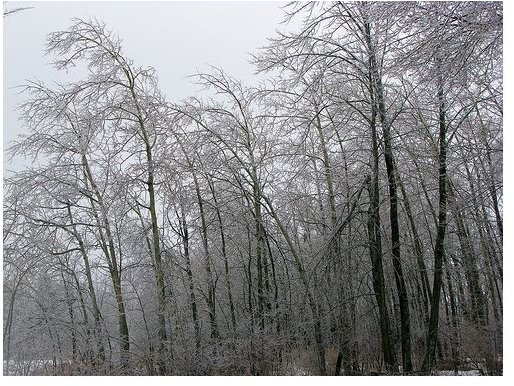Bacteria's Role in Precipitation: Biologics found in Snow
Bacteria as Ice Nucleators
Precipitation occurs when water vapor in the atmosphere cools to temperatures where ice crystals forms. This happens at the extremely cold temperatures of -40F; the temperature in the upper troposphere. At these cold temperatures water vapor forms ice crystals spontaneously. However, most precipitation forming clouds are found in the lower and middle troposphere because of the presence of ice nucleators. There are many different kinds of ice nucleators; dust particles from meteors, inorganic soil particles and finally biological particles. Biological particles include pollen, algae, dandruff and bacteria.
Bacteria are particularly effective at forming ice at temperatures closer to freezing and it is not surprising that the majority of ice nucleators are bacteria. This fact is according to a paper published in the Science February 2008, where Christner, et al. found that the majority of ice nucleators in the lower and middle latitudes of the troposphere were biological in origin. This suggested that biological particles were important in the precipitation cycle.
In another paper published in the Proceeding of the National Academy of Sciences, Christner, et al, collected samples of precipitation from the United States, France, Antarctica, and Canada. The researchers digested some of the samples with lysozymes to disrupt the bacterial cell wall and heat treated some samples to destroy the bacteria. In both groups of treated samples, there was a reduction or elimination of the ice nucleation ability.
The researchers concluded that the nucleation was the result of live bacteria which were destroyed during the testing. The appearance of bacteria in such a widespread of locations suggested that the effect of bacterial ice nucleators was prevalent. The bacteria were even found in the samples from the Antarctica showing how far the bacteria have traveled. According to Christner, the bacteria were mostly linked to plants; an observation he believes will help forecasting climate and show how terrestrial vegetation affects climates.
Implication of Bacteria in Precipitation
The most common bacterial ice nucleators are Pseudomonas syringae which are known for causing diseases in agricultural crops. There are some interesting implications that can be drawn from this research. Maybe there is some truth in the old adage about catching a cold from being out in the rain. If bacterial ice nucleators are in the precipitation then it stands to reason that the precipitation can make you sick. Joel Forman of the American Academy of Pediatrics committee of environmental health disagrees, he points out that the chances are slim for catching a disease via ingestion of snow.
The bacteria in the atmosphere are not passive, they survive using stored energy resources, going as far as breaking down carbon sources to satisfy their biochemical needs. From this information the actual role of the bacteria may become a tool in pollution degradation in the atmosphere.
Skeptics Question the Results
There are skeptics to the role of the bacteria in precipitation. Karen Junge’s lab, in the Applied Physics Laboratory at the University of Washington, Seattle, has set up an experiment mimicking the conditions in the atmosphere to test the ice nucleation ability of Pseudomonas syringae. Her preliminary results show that in order for the bacteria to act as ice nucleators, they need to be in higher concentrations than those found in atmosphere.
Photo Credit: https://www.flickr.com/photos/omakakii/3380290637/
